Who would have thought that we can make Umeboshi pickled plums out of Rhubarb? Whoever thought of making mock Umeboshi from Rhubarb is a genius because it seriously tastes just like real Umeboshi. This is a brilliant idea for those who want to use it in their cooking or just want to experience what it tastes like.
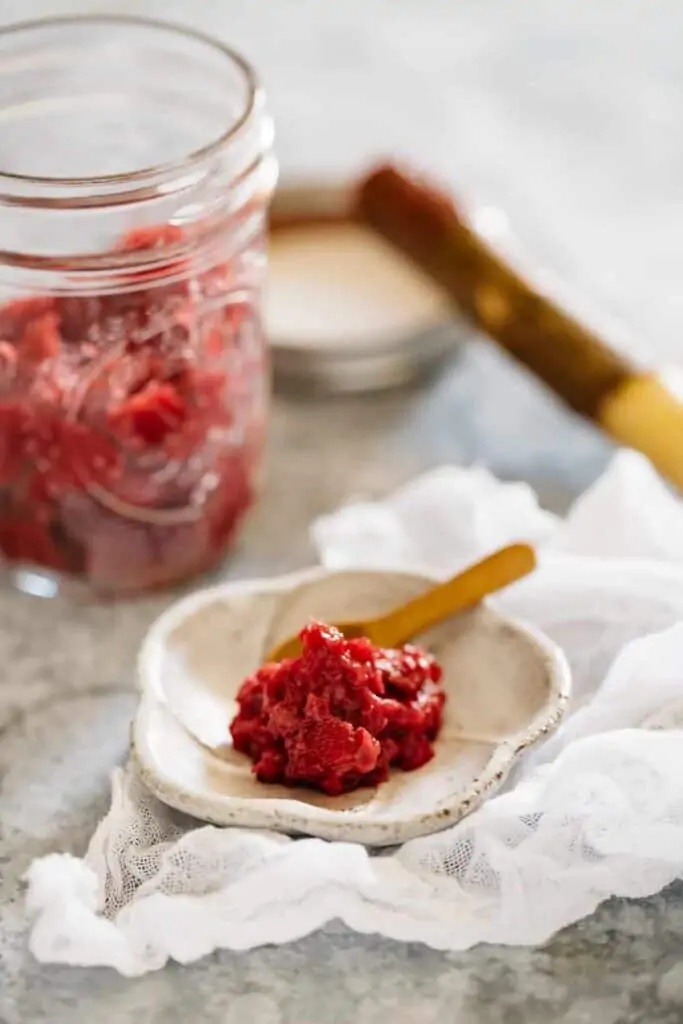
So just what is Umeboshi?
Umeboshi is a Japanese name for pickled plum with salt, also known as salted plum or umeboshi plums. Ume means ume fruits, which are called plums but more close to apricots, and boshi means dried. So it is literally means dried ume fruits. The size and color vary. Some are large, soft, wrinkly and dark red, some are tiny, crunchy, no wrinkles and pinkish red.
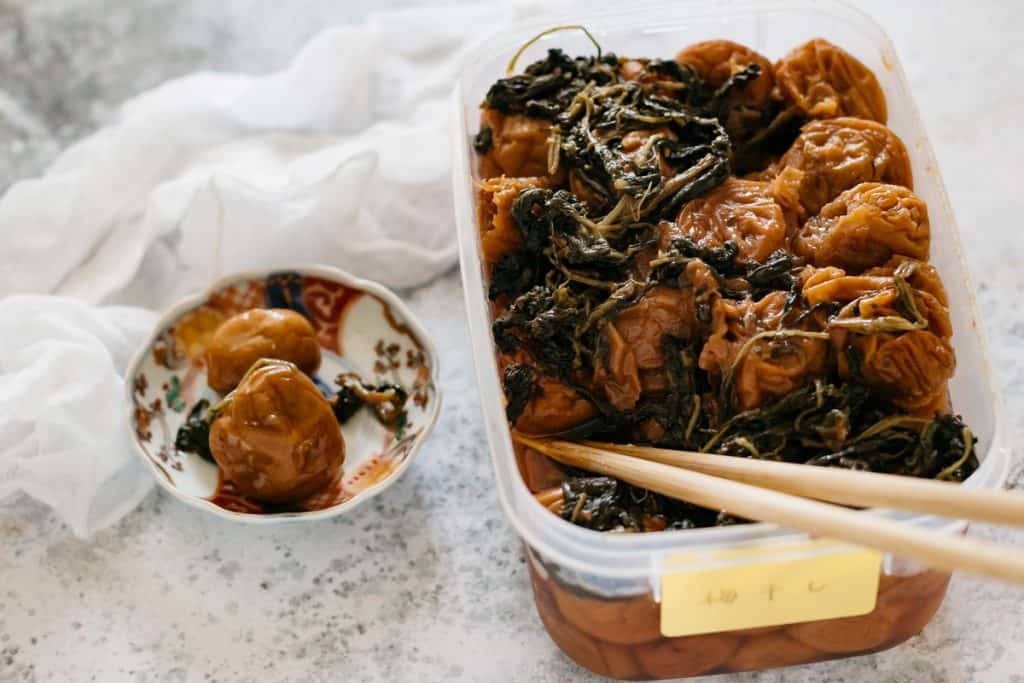
What does it Taste Like?
It is traditionally just pickled fruit with around 20% salt. So it is quite salty and tastes also sour from citric acid. However, there are many varieties in taste nowadays as some have added honey and bonito flake. Honey pickled Japanese plums are popular souvenirs among Taiwanese and Chinese tourists because of its salty-sweet taste. My personal favorite is the one with bonito flake added called “Katsuo Ume” with an extra umami kick.

How Japanese use it in Japanese cooking?
You may have seen Umeboshi used for topping or as a filling of Onigiri rice balls or in the middle of plain rice in a Obento box for its antibacterial and preservative effects. Also umeboshi paste is used for salad dressings, pasta sauce, and toppings for chilled tofu.
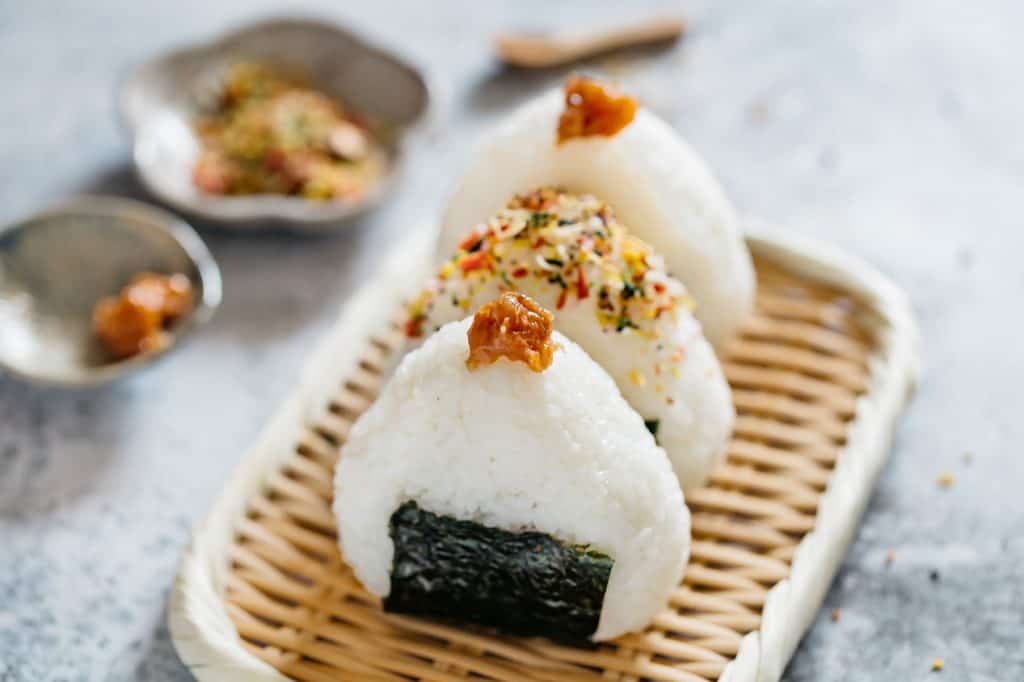
Where do you buy Umeboshi Plums?
Usually, Asian/Japanese grocers stock them regularly as it is traditional Japanese condiments and Japanese people overseas still eat them often like I do. Also, some health shops stock them for the health benefits of umeboshi. Umeboshi is a good source of polyphenols. You can get Umeboshi Plums with Katsuobushi Bonito Flakes and Red Shiso online such as Amazon.
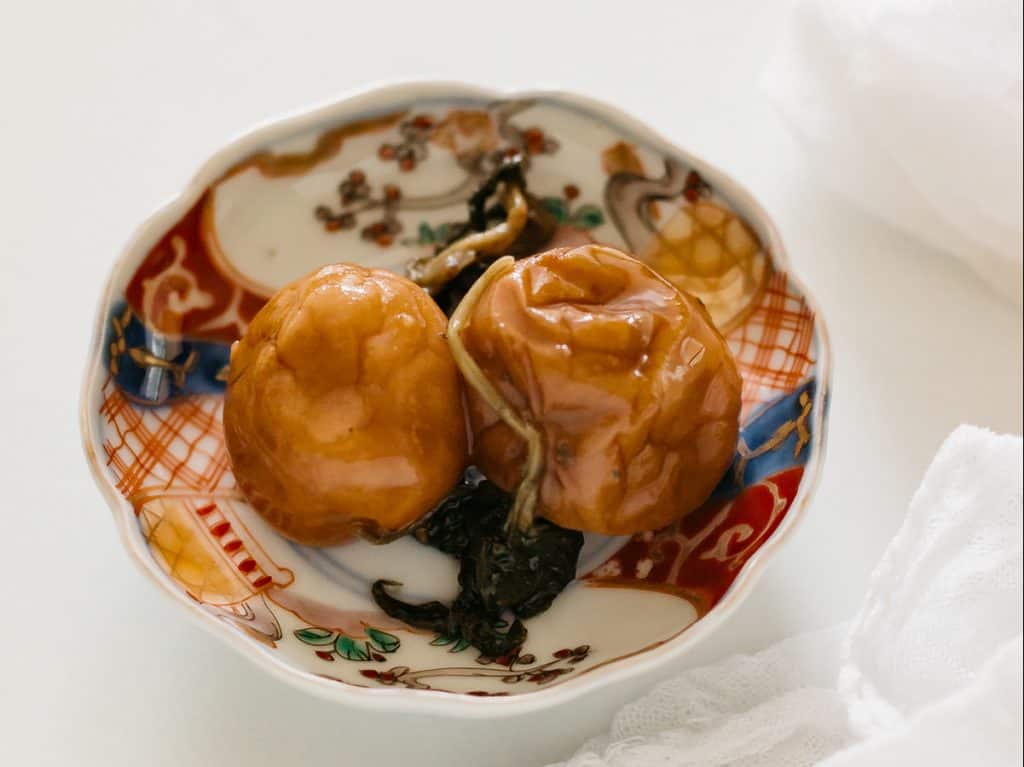
How is Umeboshi made?
I am from near Minabe which is famous for the best Nanko Ume in Japan. As a young girl, I would help my grandma who had two ume trees in her vegetable patch. Together we would harvest and clean the plums, then start the pickling process. Basically, after harvesting and cleaning the ume plum, they are pickled with 20% of salt with a weight on top for a few days until most of the moisture comes out.
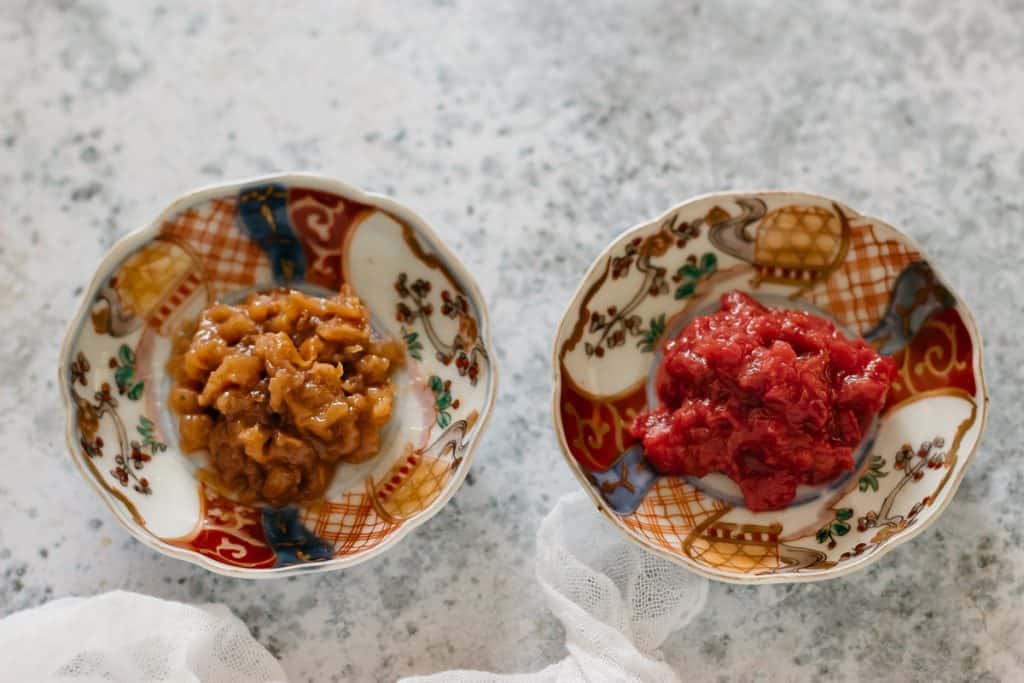
Then it is sun dried which is called “Doyōboshi”. Doyōboshi means that the salted plum then are dried for 3-5 dog days of summer. Yes, this is done on the hottest days. By exposing it to the strong sunlight in summer it suppresses the growth of mildew and condenses the flavor. Then you can eat them straight away but it will not taste mellow at this point. It is then matured in a container for 3 months to 6 months to bring out the more intense flavor.
Alternative to plums: Rhubarb!
If you are unfamiliar with traditional Japanese cooking, making Umeboshi from scratch sounds daunting, especially when you just want to try what it tastes like. I have a great news for you. We can make Umeboshi modoki (mock) with Rhubarb. Yes I know, rhubarb! Seriously.
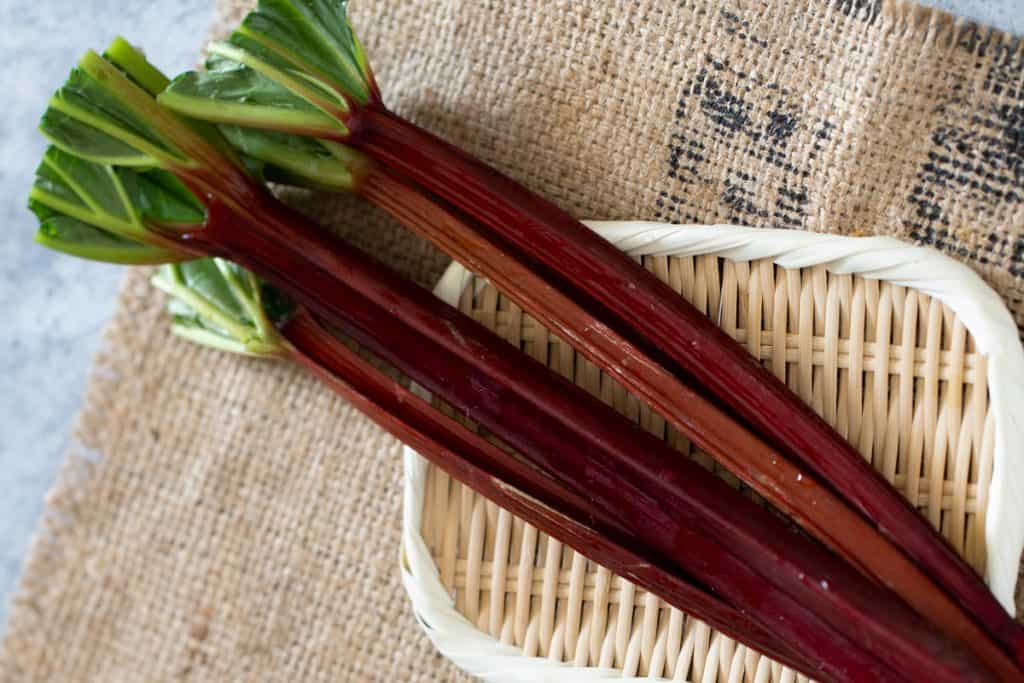
Rhubarb is an unfamiliar vegetable for Japanese people. I certainly did not know rhubarb existed until I migrated to Australia. I had never seen, cooked, and eaten rhubarb in Japan but it was actually introduced to Japan in the Meiji era in Nagano prefecture.
Why Use Rhubarb to Make Umeboshi
1. Rhubarb is easier to get than Ume plums
Rhubarb is a perennial plant native to Southern Siberia. Its leaves are not edible, only the stalk part is used for making jam and often used to make sweets. So for people who live outside of Japan, you can use rhubarb.
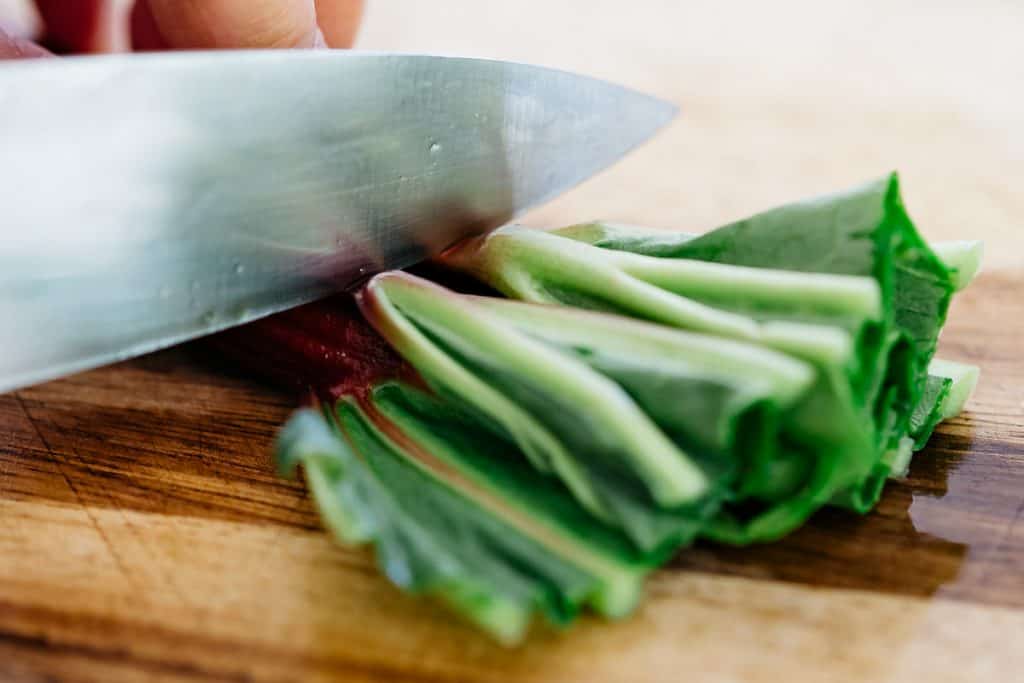
2. Similar texture when it’s cooked
The texture when Rhubarb is cooked is very similar to the texture of soft Umeboshi paste, so it is suitable to make mock umeboshi. The taste is just like the real thing.
3. Can be made in 35 minutes
In comparison to making real Umeboshi, it is super easy to make in a shorter period of time. Unlike making real pickled plums, using rhubarb does not require much care and time.
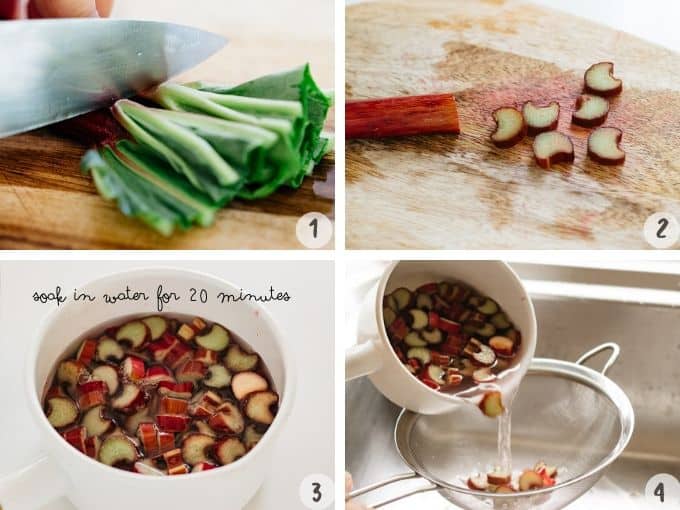
Three Tips to Make Great Mock Umeboshi
1. Pick the best possible Rhubarb.
Umeboshi is usually reddish in color because it is pickled with red Shiso leaves. There are two types of rhubarb: the red-colored stalk and the green one. In my opinion, the reddish one makes it look more similar to pickled plums as when it is cooked the color becomes a brilliant red. The thinner the stalk, the more red in color the paste will be.
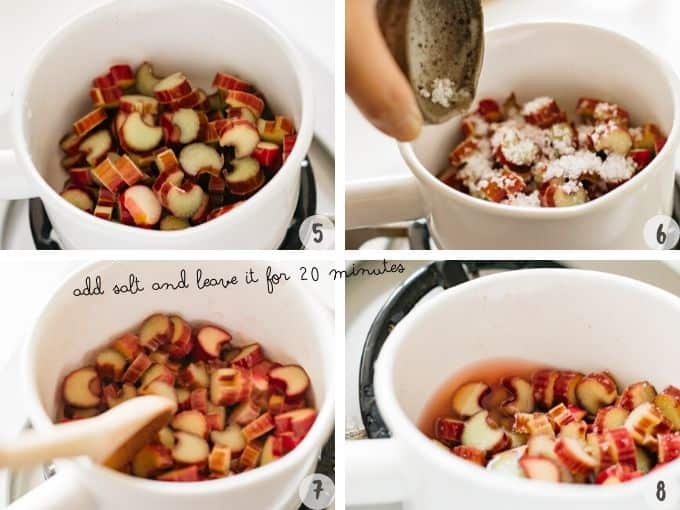
2. Remove the astringent taste
Cut and soak the rhubarb in water to remove the astringent taste, for no longer than 20 minutes. It may lose acidity as well as the astringent taste if it is left in water longer. We want the acidity [process photo 3 and 4].
3. Withdraw moisture out of the rhubarb
No need to add water. After soaking in water and drain the water, sprinkle salt over it. This process will withdraw some water out of the rhubarb [process photo 5 – 8].
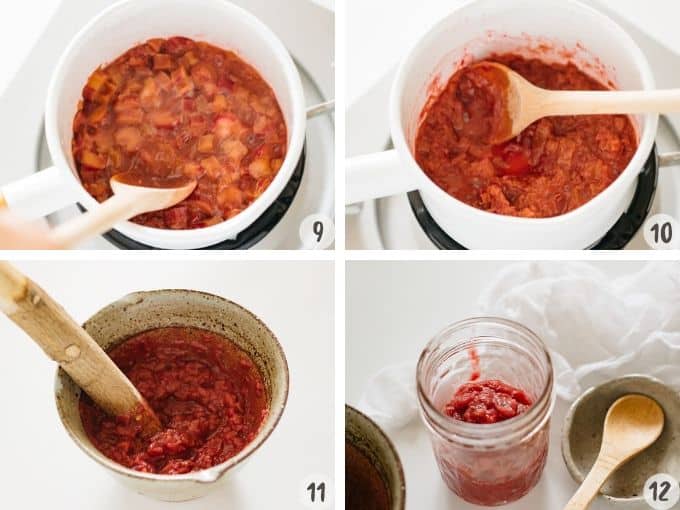
How to store
Real umeboshi is stored in a container in a cool cold place. It is said to last for 2-3 years or longer if the umeboshi is made with 20% salt content. This pickled rhubarb has only 10% salt content and does not last like real umeboshi. It will last about 2 weeks in fridge from my experience.
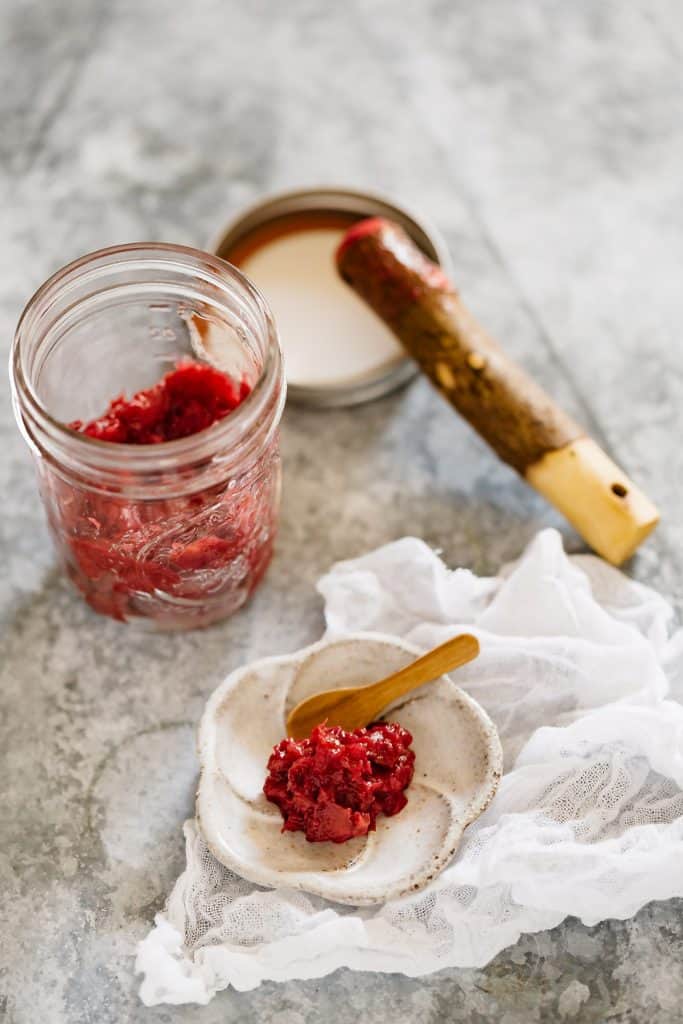
Stay Connected
Here is my instruction for Umeboshi Rhubarb and If you like it, please rate it and leave a comment below. Also, don’t forget to follow me on Youtube, Pinterest, Facebook , Twitter and Instagram to keep up to date with all the latest happenings on Chopstick Chronicles. Don’t forget to use the hashtag #ChopstickChronicles so I can see your wonderful creations!
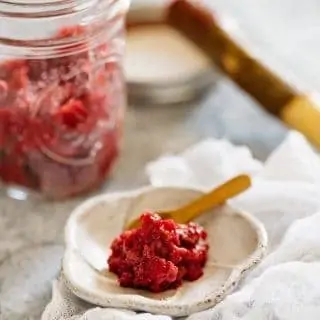
Instructions
- Wash and cut the rhubarb to about 0.4 inch (1 cm) wide.
- Soak them in a bowl of water for 20 minutes. *2
- Drain the soaking water and sprinkle salt over the rhubarb.
- Leave it for 20 minutes in order to withdraw some of the water.
- Place them (with the water that comes out) in a small saucepan and cook over low heat for 7 -10 minutes.
- Turn the heat off and transfer it to a Japanese mortar. Mash it in the mortar. *3
- Keep it in a sterilised jar in the fridge. *4
Video
Notes
Nutrition
Chopstick Chronicles is a participant in the Amazon Services LLC Associates Program, an affiliate advertising program designed to provide a means for sites to earn advertising fees by advertising and linking to Amazon.com. As an amazon associate I earn from qualifying purchases.
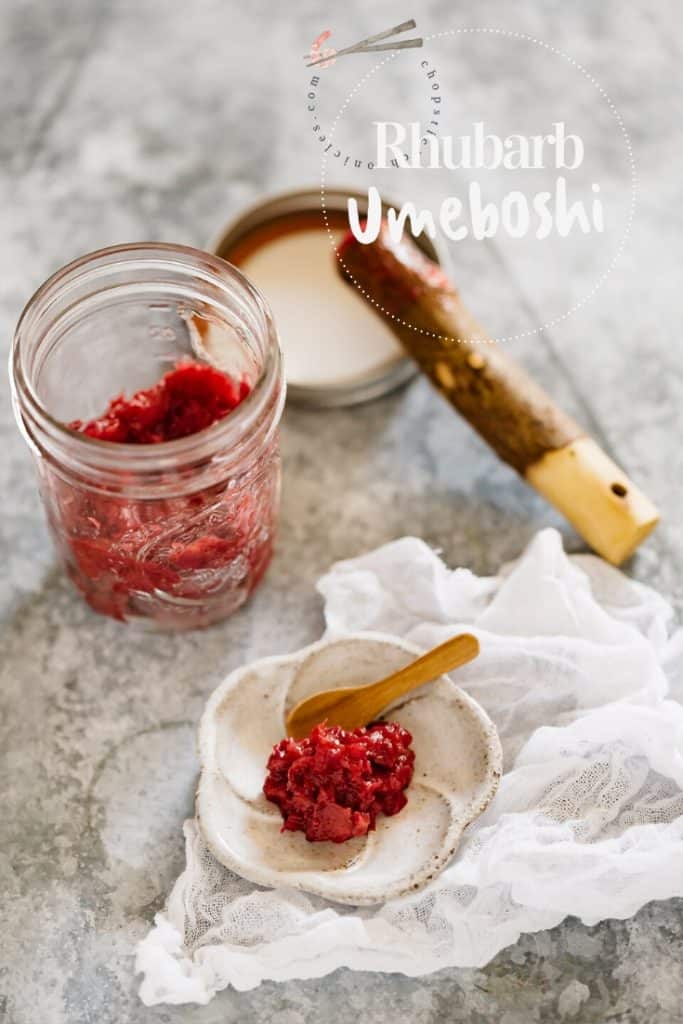
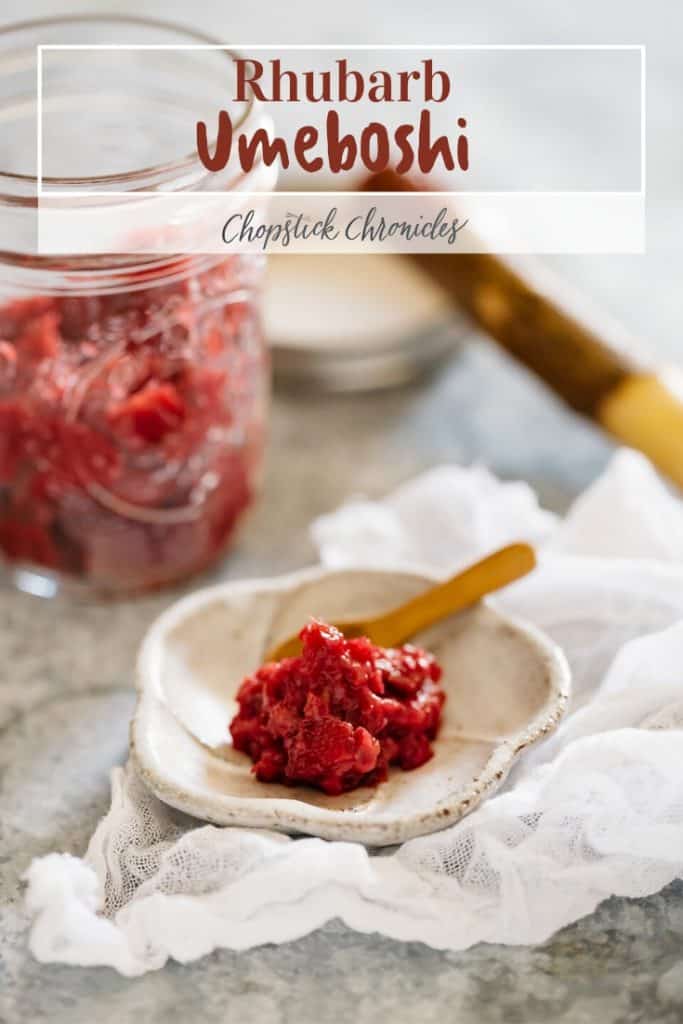
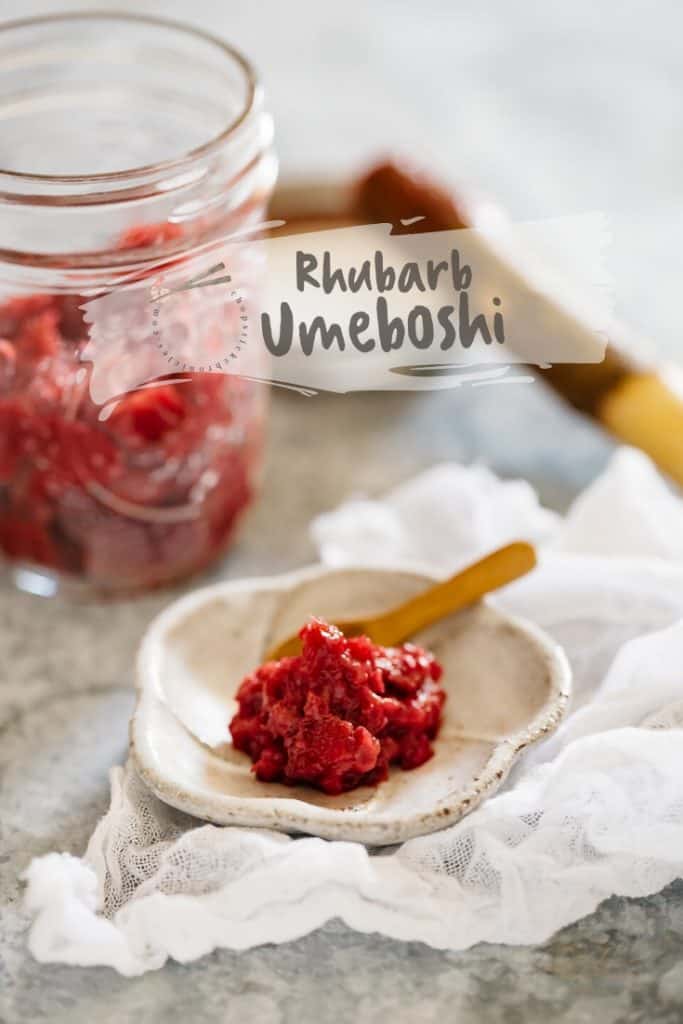
Hello! Thank you for this recipe. I am about to try my hand at it. I was wondering, I have a huge crop of red shiso, would you include shiso in this paste? I am looking for uses. Thank you
Hi Brigitte, yes you can and it will add nice shiso flavour <3
What a great idea !! Will try it in coming weeks ! Thanks
That’s fantastic, Lara
I am so thrilled to have found this recipe! Thank you for sharing. I live in Canada. As you said it’s harder to find plums (I am growing some Janapese plums this year but won’t have my fruits till much later). We do have lots of rhubarb – can not wait to try!
Hello there.
Am I doing something wrong? I triples the recipe as I had alot of rhubard, but my paste just tastes of salt. What have I done wrong?
Thank you
Oh my god, thank you so much for this recipe! I write and work mostly for a German (macrobiotic) public, Rhubarb is in season there right now… I immediatly told everyone to give it a try because I am currently living on the Canary Islands and do not have Rhubarb here 🙁 Tried to make something “Umeboshi”- similar with dried Apricots, sea salt and pickled Shiso leaves (pressed)… turned out to be a nice condiment but well, obviously its not “sour” or “tangy” enough..
Sending you best wishes from Tenerife,
Nora
Thank you so much for this recipe! I made it this morning with rhubarb from my garden. It was very green, so I added red and blue food coloring in a ratio of 4:1 drops to give it a nice umeboshi color. Then made onigiri with that, green onion, and cucumber. So yummy. Thank you again 🙂
Awesome, tastes just like ume without seed, had to ask produce department to get rhubarb in Hawaii supermarket but worth it. Recipe and directions were easy to follow and I have purple shiso growing in my weedy yard. Also added less salt in second batch and added Shiso Furikake from Japan for color and taste. Sealed two small jelly jars to preserve for later when no rhubarb in stores. Arigato for this wonderful way to make homemade Umeboshi.
You are welcome Kimie, Great addition of Shiso Fruikake 😀
Awesome, not bright red like yours, but the taste was wonderful so I ate two bowls of rice. Also added more chopped fresh shiso leaves the second batch. And boiled some in two canning jell jars to see how long I can keep it unrefrigerated.
That is fantastic Jeanne, because of amount of salt used, it keeps well but I would refrigerated it.
After I cook the rhubarb in the pot and put in the mortar, do I drain excess liquid out or mash it in with the rhubarb? Thanks for the awesome recipe! Can’t wait to try it
Hi Ashaya, I cooked until almost all liquid evaporate so after mash them no liquid left over.
I made this yesterday and it was great new discovery. Being Japanese I like very sour Umeboshi so I will probably soak it for 10 minutes next time and cut it bigger for more crunch. Have your tried making rhubarb as umeboshi following the traditional umeboshi steps? I am curious if that would work? I saw a different sweet recipe from Iceland for Rhubarb Raisens. In that recipe you dry the rhubarb in the sun and it dries like ume. I will keep experimenting as I have a lot of rhubarb to use. Maybe you can make umeshu also but with rhubarb then? Interested if you have results from any other rhubarb/ume idea recipes. Thanks for sharing.
Hi Michiko san, Thank you for your feedback :D. Yes, it would be interesting if Umeboshi with Rhubarb can be made in the same way that real Umeboshi is made and also the idea of making Umeshu. I have not tried any other Rhubarb/Ume recipes. I will be keep experimenting too and please share if you have good one 😀
I made this recipe because I had a lot of rhubarb and was very intrigued at how this would work. I made a big Japanese bento picnic and put this out for the condiment. It was really interesting and delicious with inarizushi. I will tell all my Japanese friends!
Debra
Thank you Debra, isn’t it? I could not believe it myself when discovered about Umeboshi rhubarb too, it really like real Umeboshi doesn’t it!?
Hi!
I am wondering how long this keeps for in the fridge? If it doesn’t last long could it be frozen? The reason I ask is because I have lots of rhubarb and love umeboshi. Where I live umeboshi is expensive as well as it contains MSG which if I can stay away from I would rather do so. I am also thinking of adding some shiso leaves if I can find them to help give more authentic flavour. Thanks in advance. I am really hoping that it can be frozen or last long. I made fukujinzuke and froze in small batches, which is really good.
Thank you!
Hi Nadia Thank you for your comment. It does keep in fridge long time becauses of amount of salt in it, but I have not calculated exactly. I also think freezing is not bad idea too but I have not tried it. IF you adding shiso, find purple one 😀
Hello, thank you so much for sharing this! I will be making it and I’m already curious about how it will taste! Could you let me know how long it keeps in the refrigerator?
Hi Amy, because of the amount of salt, it lasted long time in my fridge.
That’s good to know, thanks!
Hello Shihoko,
A few days back I discovered your website and tried out 3 of your recipes that same day.
I made this Umeboshi modoki. I love umeboshi so I had to try this one and I love it! It is such a surprising way to make it with rhubarb and that resembles the original recipe.
Next I made Goma Ae. So easy and still so flavorfull!
Third, I made Sunomono. I had to make it with regular big cucumber but it was still very good. I can not wait to try it out with the little ones you talk about.
I loved all three recipes and wrote them down in my little recipe book where I collect the best ones.
Thank you so much for sharing.
Ra
Hello Ra, Thank you so much for trying those three recipes and I am glad to hear that you liked it. Umeboshi was my surprise too!! since I can not get Ume from where I live, now I often make this as Rhubarb is always available 😀 Happy cooking!
Ooops !
I misspelled your name: Shihoko-San
Go-Men-Na-Sai.
Shiroko-San
Regarding: “Really? everyone knows Japanese food in Hawaii? is it because large Japanese population there?”
LOL !
You would be pleasantly surprised at the number okazu-ya and restaurants in Hawaii.
Even places like 7-11 sell bentos.
Ohhhh really? I have never been to Hawaii. I know Hawaii is popular travel destination for Japanese but did not know there are so many Japanese shops 😀
I was wondering about motor…….is it mortar? Anyway i find your weekly recipes a welcome treat. Raised in Hawaii, everyone knows about Japanese food and frankly that is my favorite. I especially have fond memories of visiting many Okazu business when I lived there. Oh yummy.
Thanks for all your efforts.
Hi Ray, Thank you yes it is mortar. English is my second language and usually my daughter edit but she missed it. Really? everyone knows Japanese food in Hawaii? is it because large Japanese population there?
What a great tutorial! I’ve never heard of umeboshi before, but I do love rhubarb and always say I want to cook/bake with it more, so this is the perfect project for me!
Thank you Sues 😀 I did not think rhubarb can be savoury until I saw my instagram friend made this.
Learned so much about umeboshi, I had no idea. Saving this for later!
Thank you Helene. I am glad to know that the post was useful 😀